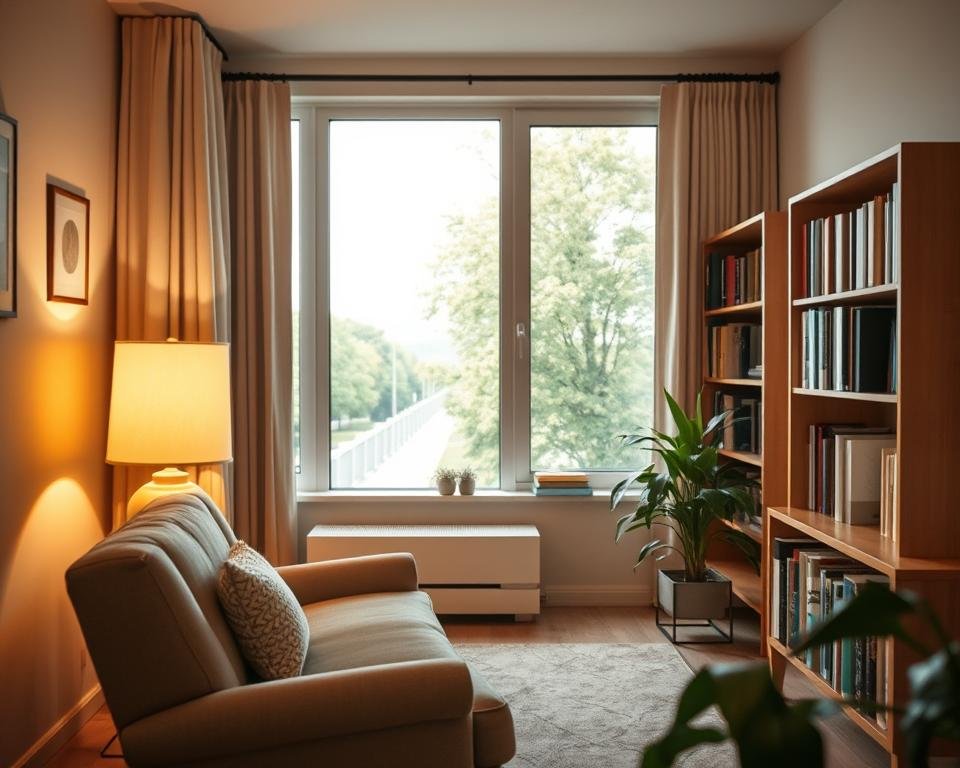“The purpose of life is to live it, to taste experience to the utmost, to reach out eagerly and without fear for newer and richer experience.” – Eleanor Roosevelt’s words ring true for anyone stepping into a new chapter. Transitioning to a smaller, safer space isn’t about loss—it’s about gaining freedom. Imagine a home that’s easier to manage, closer to loved ones, and tailored to your needs.
Did you know 64% of retirees choose to simplify their living arrangements? According to HomeHousingDownsizing, starting early with decluttering can cut stress by half. Smaller spaces mean fewer repairs, lower costs, and more time for what truly matters. Think cozy mornings instead of weekend yard work!
Creating a plan now saves money and energy later. For example, sorting belongings into categories like “keep,” “donate,” or “share with family” makes decisions clearer. Need help? Professional organizers specialize in turning overwhelm into progress. They’ll guide you through timelines and even handle item sales.
This guide walks you through each step—from choosing your ideal space to settling in with confidence. Let’s turn this transition into an adventure worth embracing!
Key Takeaways
- Early planning reduces stress and creates financial flexibility.
- Smaller homes improve safety and cut maintenance time.
- Decluttering early helps prioritize meaningful belongings.
- Professional support streamlines the process emotionally and logistically.
- A clear timeline prevents delays and keeps goals achievable.
Understanding the Need to Downsize
Moving to a cozier space can unlock unexpected perks, like saving thousands annually on household costs. Over 72% of older adults report lower utility bills after transitioning to a smaller residence, according to National Housing Institute data. Let’s explore how simplifying your environment supports both your wallet and well-being.

Financial Benefits and Cost Savings
A compact home means fewer rooms to heat, clean, or repair. Property taxes and insurance premiums often drop by 30-40% in smaller properties. Imagine redirecting those funds toward hobbies, travel, or family visits instead of endless upkeep.
Improved Safety and Accessibility
Single-level layouts and grab bars in bathrooms reduce fall risks by 60%, per CDC reports. Open floor plans eliminate tripping hazards while making daily tasks easier. Less clutter means quicker navigation—no more squeezing past furniture or stacked boxes.
Decluttering early creates breathing room in your routine. A 2023 survey found 68% of retirees felt lighter emotionally after releasing unused items. Upcoming sections will walk you through room-by-room strategies to streamline belongings without losing cherished memories.
Downsizing Preparation Tips for Seniors: A How-To Guide
Ready to create your roadmap for a smooth transition? Let’s break it down. First, explore your new home options—compare independent living communities with assisted living services based on your current and future needs. Visiting multiple locations helps you visualize daily life in each space.

Give yourself plenty of time to plan—experts at HomeHousingDownsizing recommend starting 6-12 months before your target move date. This buffer lets you research, declutter thoughtfully, and avoid rushed decisions. Create a checklist with milestones like “finalize floorplan measurements” or “schedule donation pickups.”
Lean on your loved ones and professionals early. Estate sale organizers can handle item valuations, while movers specializing in senior relocations ensure fragile heirlooms arrive safely. One client shared, “Having a team made me feel supported, not overwhelmed.”
Finally, celebrate progress. Each box packed or decision finalized brings you closer to a new space designed for ease. With this guide, you’ll navigate logistics confidently—and open the door to your next adventure with clarity.
Setting a Timeline and Organizing Your Move
Ever feel like moving day sneaks up faster than a grandchild’s birthday? A well-structured timeline turns chaos into calm. Start by marking your target move date on the calendar, then work backward to assign tasks. This creates breathing room to handle surprises—like that antique dresser that needs special packing.

Planning Early for a Stress-Free Transition
Here’s a secret: six months is the sweet spot for most transitions. Break your plan into bite-sized steps. For example:
- Month 1-2: Measure rooms in your new house and sketch furniture layouts
- Month 3-4: Sort possessions room by room—tackle the garage first
- Month 5: Label boxes by room and priority (e.g., “Kitchen – Open First”)
- Month 6: Confirm movers and share your floorplan with helpers
Early sorting lets you rediscover forgotten treasures. One client found her mother’s wedding ring tucked in a jewelry box—a joyful moment that wouldn’t have happened under time pressure. Use colored stickers to tag items: green for “keep,” yellow for “family,” red for “donate.”
Involve loved ones early. Ask: “Could you help sort photos the second weekend?” or “Which chair would fit your living room?” Their input eases decisions and strengthens connections. Need extra hands? Professional organizers can map out your entire process in a single consultation.
Think of it like baking a cake—each step matters, but you don’t frost it before it’s cooled. With a clear roadmap, you’ll glide through logistics and arrive at your new front door ready to thrive.
Room-by-Room Decluttering and Home Organization
Ever stared at a crowded closet and thought, “Where do I even start?” Breaking your home into manageable zones transforms overwhelming tasks into achievable wins. HomeHousingDownsizing’s research shows tackling one area at a time reduces decision fatigue by 43%.
Start Small: Kitchen and Living Areas
Begin with spaces you use daily. Clear countertops first—sort utensils into “daily use” and “special occasions.” One client shared, “Donating my duplicate pans gave me space to breathe—and bake cookies again!” Living rooms often hold sentimental items. Try this:
- Remove items blocking walkways
- Keep 1-2 photo albums per family member
- Donate books you’ve read or won’t reread
Sort, Label, and Prioritize Your Belongings
Create three bins: Keep, Donate, Toss. Handle each object once—hesitation wastes time. Use colored tape to mark boxes by room and priority level. Yellow labels might mean “Open First,” while blue indicates “Seasonal Storage.”
Digitize Keepsakes for a Clutter-Free Space
Scan letters, children’s artwork, and vacation photos into cloud storage. Services like Forever Storage preserve quality while freeing physical space. Frame a few favorites—rotate them seasonally for fresh decor without bulk.
Remember: This process isn’t about losing memories. It’s making room for new experiences. As you work through each area, you’ll rediscover what truly matters—and create a home that supports your next chapter.
Finding the Perfect New Home or Community
Choosing where to thrive next requires equal parts heart and strategy. Start by researching local community options that match your daily rhythm. Whether you prefer quiet neighborhoods or vibrant social hubs, the right place blends independence with accessible support.
Explore What Fits Your Lifestyle
Visit multiple living facilities to compare amenities like fitness centers, meal plans, and transportation. Ask: “Can I host family dinners here?” or “Where’s the nearest pharmacy?” One resident shared, “The art studio sealed the deal—I finally have space to paint!”
Balance Care Needs and Social Connections
When considering assisted living, focus on staff-to-resident ratios and emergency response times. Accredited communities often offer tailored care plans alongside group activities. Look for shared gardens, game nights, or volunteer opportunities—these things foster friendships while maintaining privacy.
Tour during mealtimes to gauge the atmosphere. Notice how residents interact—are conversations lively? Does the staff know everyone’s name? Bring a list of questions about pet policies, guest rules, and storage options. The answers will reveal whether this home supports your vision of comfort.
Remember: Your new community should ease stress, not add it. With thoughtful planning, you’ll find a space where every day feels purposeful—and where help is always nearby when needed.
Managing Emotions and Embracing Change
Change often feels like walking a tightrope between nostalgia and excitement—especially when letting go of a home filled with memories. Senior living experts note that 58% of older adults experience mixed emotions during transitions, from grief over leaving possessions to anticipation for simpler days. The key? Balance reflection with forward momentum.
Staying Positive Through the Transition
Focus on what you’re gaining: more time for hobbies, easier access to friends, and freedom from maintenance. One resident shared, “I traded my lawnmower for museum memberships—best decision this year!” Celebrate small wins, like clearing a drawer or labeling boxes, to maintain momentum.
Create a “joy list” of activities your new life will allow—coffee mornings with neighbors, art classes, or weekend visits with family. Refer to it when doubts arise. As Dr. Linda Harper, gerontology specialist, advises: “Anchor yourself in purpose, not possessions.”
Enlisting Help from Family and Friends
Invite loved ones to sort items together—they might cherish that vintage lamp or photo album you’re unsure about. Schedule a “memory afternoon” where you share stories while packing. It transforms chores into bonding moments and lightens the emotional load.
Delegate tasks based on strengths: tech-savvy grandkids can digitize photos, while organized nieces might manage donation drop-offs. Remember, asking for help isn’t a burden—it’s an invitation to create new memories.
With a clear plan and supportive circle, you’ll navigate this chapter with resilience. Every box packed isn’t just an ending—it’s the first page of your next adventure.
Conclusion
Stepping into a smaller home opens doors to newfound freedom and simplicity. By prioritizing safety and comfort, you’ll create a space that supports your daily rhythm while cutting costs and maintenance time. Remember: letting go of excess possessions isn’t losing—it’s making room for experiences that truly matter.
Start by mapping your moving timeline early, then tackle one room at a time. Sorting things into “keep,” “share,” or “donate” piles streamlines decisions. Use storage solutions like digitizing photos or labeling boxes clearly to stay organized. Lean on help from loved ones or professionals—they turn overwhelming tasks into manageable steps.
Your ideal community awaits, whether it’s a quiet neighborhood or a vibrant senior-living hub. Focus on places offering accessibility and social connections to enrich your next chapter. With thoughtful planning, this transition becomes less about leaving behind and more about stepping forward.
Embrace this change as an invitation to design a life centered on joy, not clutter. You’ve got the tools—now take that first confident stride toward a lighter, brighter future.
